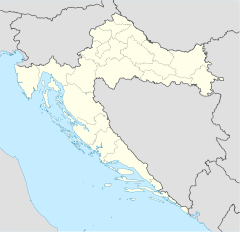- Church of Holy Salvation, Cetina
-
Church of Holy Salvation Crkva Svetog Spasa 
Church of Holy SalvationLocation Vrlika, Croatia Country  Croatia
CroatiaDenomination Roman Catholic The Church of the Holy Salvation (Croatian: Crkva Sv. Spasa) is a Pre-Romanesque church in Split-Dalmatia county, Croatia. The exact location of the church is in a small village of Cetina, in inland of Dalmatian Zagora, on spring of river Cetina, 8 km northwest from the town of Vrlika.
This church is one of the most important in Croatia, as it is the pre-schism church constructed with a bell tower which is still standing. Its was a large stone church for that period. The church is a one-longitudinal-nave structure with a sanctuary consisting of three apses, in the form of a trefoil. Later, the middle apse was pulled down and substituted by a bigger, rectangular one. The church has strong semi-circular buttresses that give a feeling of fortification, emphasized with mighty bell-tower positioned in front of entrance.
Contents
History
Church of Holy Salvation in front of Dinara mountain
In the 9th century, probably during the time of Duke Branimir of Dalmatian Croatia, this old Christian church was built near Vrlika, then called Vrh Rike.[1] It is one of the oldest and best preserved monuments of the early Croatian sacral architecture.[2]
The church was built by Gastika of Cetina "Cetinski župan Gastika" in memory of his mother and his sons.[3] During the excavation work, several architectural fragments and pieces of stone furnishings adorned with "pleter" (interlace ornaments-meaning to weed) have been found. The most important is the fragment of a beam with semi-uncial inscriptions from it is known that the church had been dedicated to Christ and built on the order of the prefect Gastika, the son of Nemira. There are over 1,026 old Croatian[1] graves around the church of great archaeological interest.[4] Several tombs have been found in the church itself, most of which (more than 800) originally had stelae. The culture of that time was influenced by the Frankish Empire, which was noticed in the archaeological findings from the period and the structure of the church.
In the early 15th century when Hrvoje Vukčić Hrvatinić (Kotor around 1350–1416) Ban of Croatia, Grand Duke of Bosnia and a Herzog of Split strengthened the Prozor Fortress, most of inhabitants moved from Vrh Rika to Vrlika for the protection of the fortress. After 1492 and the invasion by the Ottoman Empire, the church sustained heavy damage and the remaining inhabitants fled to Vrlika or further.
The 17th century saw new inhabitants from Bosnia (Ottoman Muslim, Serbian Orthodox, Roman Catholic Croats and Croatian Greek Catholic) settle in the area near the church. Most of them where Orthodox, whose graves today are mixed with the old Croatian graves
The church was mostly used as a Catholic Church, except for the time between World War II and the Croatian War of Independence when it was also used as an Orthodox Church.
See also
- Architecture of Croatia
- Church of Saint Cross
- Church of St. Donatus
- Hollow Church
References
- ^ a b "Znanost u Hrvata: prirodoslovlje i njegova primjena [Centuries of Natural Science in Croatia: Theory and Application]" (in Croatian). June - October 1996. http://public.carnet.hr/zuh/do1874/srv/srv_2.htm#1. Retrieved 2010-10-03.
- ^ http://www.croatia-a-la-carte.com/site.php?NavID=Regionen&RegionID=3&SubregionID=23&OrtID=71&LANG_SET=EN
- ^ http://web.archive.org/web/20091026110447/http://geocities.com/kijevo01/sv_spasa.html (Croatian)
- ^ http://www.vrlika.hr/podstranice/povijest.html Official site of Vrlika (Croatian)
Further reading
- Soldo, Josip Ante (2001) (in Croatian). Vrlika - Monografija. Šibenik: Viatoni. ISBN 953-98670-0-2.
External links
Categories:- Churches in Croatia
- History of Croatia
- Archaeological sites in Croatia
- Fortification
- Medieval architecture
Wikimedia Foundation. 2010.



